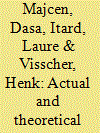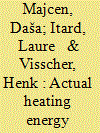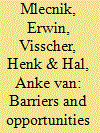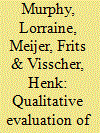|
|
|
Sort Order |
|
|
|
Items / Page
|
|
|
|
|
|
|
| Srl | Item |
| 1 |
ID:
125538


|
|
|
|
|
| Publication |
2013.
|
| Summary/Abstract |
Energy labels in buildings are awarded based on theoretical gas and electricity consumption based on dwelling's physical characteristics. Prior to this research, a large-scale study was conducted in The Netherlands comparing theoretical energy use with data on actual energy use revealing substantial discrepancies (Majcen et al., 2013). This study uses identical energy label data, supplemented with additional data sources in order to reveal how different parameters influence theoretical and actual consumptions gas and electricity. Analysis is conducted through descriptive statistics and regression analysis. Regression analysis explained far less of the variation in the actual consumption than in the theoretical and has shown that variables such as floor area, ownership type, salary and the value of the house, which predicted a high degree of change in actual gas consumption, were insignificant (ownership, salary, value) or had a minor impact on theoretical consumption (floor area). Since some possibly fundamental variables were unavailable for regression analysis, we also conducted a sensitivity study of theoretical gas consumption. It showed that average indoor temperature, ventilation rate and accuracy of U-value have a large influence on the theoretical gas consumption; whereas the number of occupants and internal heat load have a rather limited impact.
|
|
|
|
|
|
|
|
|
|
|
|
|
|
|
|
| 2 |
ID:
150020


|
|
|
|
|
| Summary/Abstract |
The register of the Dutch social housing stock was analysed, containing 300.000 dwellings, renovated between 2010 and 2013. The main objective was twofold: to evaluate the performance gap in these dwellings before and after the renovation and to establish what renovation measures achieve the highest reduction of consumption, particularly in practice (actual savings). The results showed large performance gaps in dwellings with low R and high U values, local heating systems, changes from a non-condensing into a condensing boiler and upgrades to a natural ventilation system. Regarding the actual effectiveness of renovation measures, replacement of old gas boilers with more efficient ones yields the highest energy reduction, followed by deep improvements of windows. Installing mechanical ventilation yields a small reduction compared to other measures, but still much larger than theoretically expected. The paper shows once more that the calculation method currently in use cannot be considered accurate if compared to actual consumption. The study demonstrated that unrealistic theoretical efficiencies of heating systems and insulation values are causing a part of the performance gap. Nowadays, large datasets of buildings thermal performance and actual consumption offer an opportunity to improve these misconceptions.
|
|
|
|
|
|
|
|
|
|
|
|
|
|
|
|
| 3 |
ID:
097439


|
|
|
|
|
| Publication |
2010.
|
| Summary/Abstract |
Promoting energy efficiency in the building sector is essential if the agreements of the Kyoto Protocol are to be honoured. Different initiatives for energy labelling of highly energy-efficient residential buildings have emerged throughout Europe as an essential method to stimulate market demand, to control grants or to ensure the quality of demonstration projects with excellent energy performance.
The paper identifies the barriers and opportunities for the further diffusion of labels for highly energy-efficient houses. A model based on the theory of the diffusion of innovation is developed to analyse perceived attributes of existing European labels. The paper investigates the innovation characteristics of existing labels in Europe, with a focus on advanced countries. The question of compatibility with the development of the European Energy Performance of Buildings Directive (EPBD) is examined in detail.
We found that the diffusion of emerging and already existing voluntary European labels for highly energy-efficient houses is needed. Their complexity can be lowered and relative advantage, trialability, observability, and compatibility can be increased. EPBD calculation procedures should be able to receive highly energy-efficient houses. In the framework of the recast of the EPBD, official recognition of existing voluntary labels is recommended.
|
|
|
|
|
|
|
|
|
|
|
|
|
|
|
|
| 4 |
ID:
113457


|
|
|
|
|
| Publication |
2012.
|
| Summary/Abstract |
Climate change policies in the Netherlands recognise the importance of existing dwellings. Efforts to gain these energy savings are led at national level by policy instruments such as the Energy Performance Certificate, covenants, economic and information tools. These instruments reflect a policy style described as consensus based and incentivising. However, this approach has been subject to criticism with suggestions that alternatives are required. As a first step towards conceptualising alternatives previous evaluations and stakeholder interviews are used to assess instruments. Elements from the theory based evaluation method combined with concepts from policy instrument and energy policy literature form an evaluation framework. Results demonstrate weak impact of some key instruments. Underlying theories associated with instruments are often lost during implementation or remain unsubstantiated. Policy instrument and energy policy concepts are evident but are far from pervasive. Results show that current instruments are poorly equipped to forge a long-term energy saving strategy for existing dwellings. It is further demonstrated that complexity with existing dwellings is not only limited to frequently cited barriers but to the intricacies of designing and operating a well-orchestrated instrument mix.
|
|
|
|
|
|
|
|
|
|
|
|
|
|
|
|
|
|
|
|
|